
A solid and reliable walking axe and crampons are a necessity for heading out to the hills in winter. Here we look at Black Diamond's Raven with Grip axe and Serac crampons and assess their suitability for keen winter Munro baggers looking for an upgrade, or those thinking of taking their first steps out into the hills this winter season.
Raven Ice Axe with Grip - £110
A walking axe at a good price point, and with an exceptionally ergonomic head for holding when walking, the Raven with Grip is essentially the same as the Raven, but provides a couple of added features over the standard Raven to deliver a walking axe that is slightly more versatile and ergonomic.
In Use
The Raven (with or without Grip) serves primarily as a walking axe, perfect for maintaining balance on gentle snow slopes during winter walks and glacier traverses, and ideal for self-arresting. As such, this is rated as a Type 1 axe (previously known as a B Rated axe). It also proves useful for the short, steep sections of snow, neve, and rocky terrain typically encountered on a lot of Scottish hills in winter. Additionally, I've carried it on shoulder season outings as a 'just in case'.
I opted for the 55cm version for its ligher weight, and for facilitating easier manouevrability if quickly needing to safely arrest. Typically, if I need a longer axe to reach the snow, I'm not on a steep enough slope to require it in the first place. If you need or prefer a longer axe then, 60cm, 65cm, 70cm and 75cm (!) are also all available.

Ergonomics
The standout feature of this axe, for me, is its shaped head. Designed for a comfortable walking grip, it fits perfectly in the hand and remains comfortable for extended periods of walking - brilliant.
The pick angle on the Raven is very gentle, which makes it best for low-angled slopes, but also for improving its self arresting capabilities. When tackling short sections of climbing, the straight shaft and gentle pick angle do limit the Raven's climbing ability. I conducted a side-by-side comparison with its sibling, the Raven Pro, which features a slight curve in the shaft. This comparison clearly demonstrated that hooking over bulges or finding hand space for digging into steep slopes is significantly easier with the Raven Pro. However, I'm happy with the limitations in climbing ability given its benefits when walking, and the savings made in price.
The spike effortlessly penetrates ice and snow, although it might feel overly sharp initially for a walking axe. The adze's wide and deep shape proves efficient for creating steps or platforms.
The inclusion of a leash and a grip increases the price by an additional £15 on the standard Raven model, but we feel this still represents excellent value for an axe of this calibre. While the leash enhances versatility and reduces the chance of accidentally dropping the axe, I often find it cumbersome to use one, particularly when frequently switching hands. As for the rubber grip, it offers a slight advantage by providing extra traction during swings or self-arrests, and feels a bit warmer to hold, although these actions make up only a small fraction of its overall usage. In short, I can imagine many users opting for the classic Raven if they feel they won't see the benefits of a leash and rubber grip.
Weight and Durability
At 483g (with leash), 458g (without) it strikes a good weight for a sturdy and reliable walking axe. There are much lighter axes out there but for an entry level walking axe you may not want to pay the significantly higher prices these often retail at. Despite the solid build quality, the weight is kept down thanks to the light but robust aluminium shaft. An investment cast stainless steel head and spike bring extra toughness and quality to critical areas, and I see no reason why this axe won't last me the rest of my life!
Serac Strap Crampons - £160
A good versatile crampon that will serve you well not only when taking your early steps into the winter walking game, but also up into some easy classic mountaineering routes, the 12-point Serac crampon provides solid build quality, stable walking and compatibility with any kind of mountain boot.
In Use
The Serac crampons have proven ideal for walking in the Scottish hills this season, as well as for navigating easy snow gullies and classic Scottish Grade I and II winter routes. I've reviewed the Strap (C1) version, but there's also a Clip (C2) version suited for more extended climbing at grade II/III.
In my experience, these crampons are versatile for Scottish hills up to some low end grade II. Their C1 compatibility allows me to pack them when wearing more comfortable B1 mountain boots, anticipating occasional use, or when opting for stiffer boots for extended snow slope climbing.
Their aggressive horizontal front points and secondary points offer excellent technical performance, ensuring stable bite on steep snow slopes, ice, and occasional easy mixed terrain where standing on small edges is necessary. This stability also translates to descents or walking on low-angle terrain with their substantial rear points. However, their enhanced technical performance and longer points make them less forgiving for all-day walking on easy snow slopes. There is a natural rocker built into the Seracs which works well, but for purely walking purposes, you might want to consider Black Diamond's Contact Crampon, its less aggressive 10-point counterpart.
Weight, Packability and Durability
When comparing weight to similar competitors, the Serac is roughly comparable to the Petzl Vasak, and lighter than the Grivel G12, all at a comparable price point. At 842g on the home scales (admirably below BD's stated 860g), they aren't the lightest on the market compared to some modern aluminum models. However, if you're using them in Scotland where you're likely to spend a lot of time on rough and rocky ground with little base buildup, the durable stainless steel construction of the Serac ensures they'll last season after season. Additionally, I don't anticipate any rust forming on mine, unlike some competitors on the market. The plastic straps and belt straps also feel completely solid and would require a substantial amount of abuse to show significant damage.
When it comes to packability, the strap on the Serac adds a fair amount of bulk, potentially being the main drawback. However, you might not notice much difference compared to a pair of G12 or Vasak crampons. They feel relatively bulky in the pack, although I assume the clip version will address the issue of packability well.
Features
Balling snow in your crampons is a hazard all winter walkers and mountaineers need to be aware of. The anti-balling plates used here have performed well so far, and I have no major complaints based on the conditions I've walked in. However, compared to the superior design of the anti-balling plates on my old G12s plus the additional anti-balling system in the bar, the Serac may fall slightly short. Nonetheless, this isn't a reason to dismiss them.
While the fastening system is intuitive, I find myself constantly annoyed by the long tail of the fastening belt. To address this, I've chosen to cut it slightly and then tuck or knot it in place. I've noticed other crampons that utilise a convenient plastic clip to neatly hold the excess strap, and I wonder why this hasn't become a standard feature across all crampon manufacturers.
Summary
If you're gearing up for your first foray into mountaineering and winter walking this season, pairing the Raven with Grip and Serac Crampons would be an excellent choice to kickstart your winter adventures. For those focusing solely on walking, opting for a less technical pair of 10-point crampons might be more suitable, but if you have ambitions towards mountaineering then this 12-point model will be able to take you there, whilst still being viable for easier walking too. Conversely, if you're eyeing more technical mountaineering routes, a slightly more curved and aggressive axe could serve you better.
Nevertheless, combining the Serac Crampons with the Raven axe strikes a good balance of technical performance for walking and tackling low-grade Scottish mountaineering routes, all while remaining affordable. Both products boast excellent build quality, ensuring they'll withstand years of hard use.



















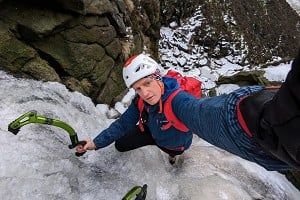
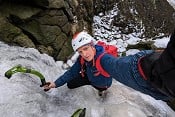
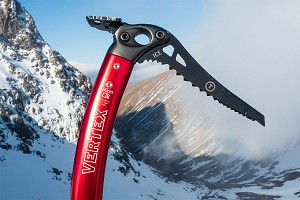
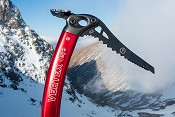



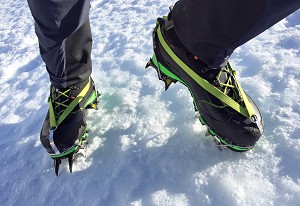
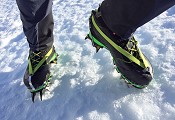

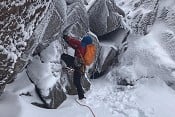
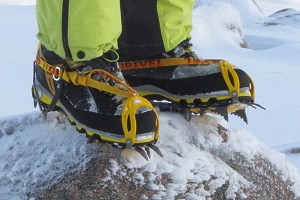
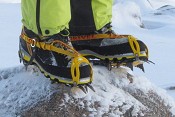
Comments
I bought a pair of Seracs, the clip version, just before Xmas. Used them twice so far, once with "B3" climbing boots - in this case my now elderly Trango Extremes. We soloed up Crib Lem, II, then did another route we reckoned to be III,4 that day and the Seracs were great. I then wore them again a few days later with these B1/maybe 2 boots https://www.ukclimbing.com/gear/footwear/mountain_boots/mammut_kento_advanced_high_gtx_boots-15962 and did Crowden Clough (Winter) (II), with a reasonable amount of ice in it. Again the Seracs were just perfect. The secondary points are nicely angled for ice, but they work just fine on mixed too. I reckon they are really classic and classy climbing crampons if you want them to be, I'm addition to be fine for walking, but maybe more than you need for just walking.